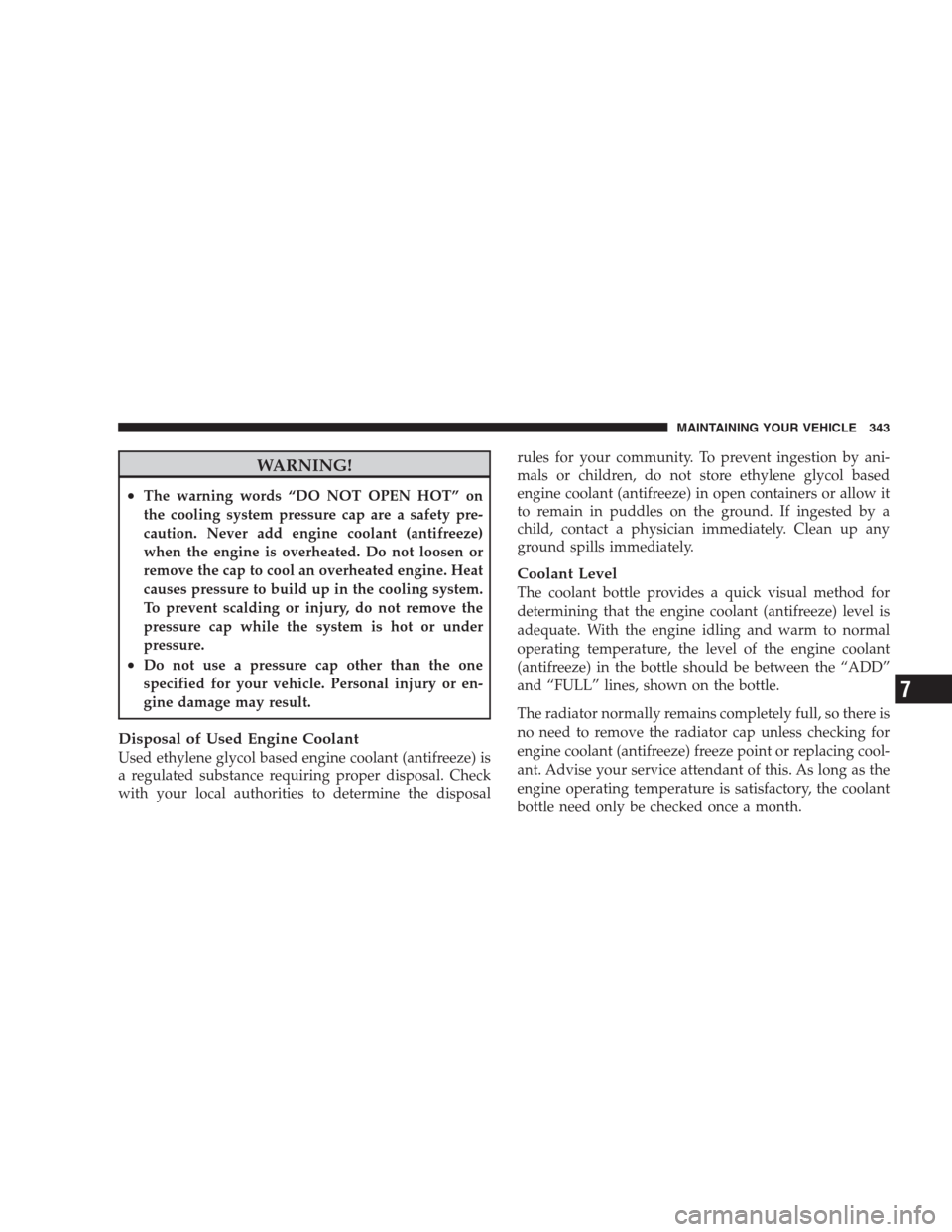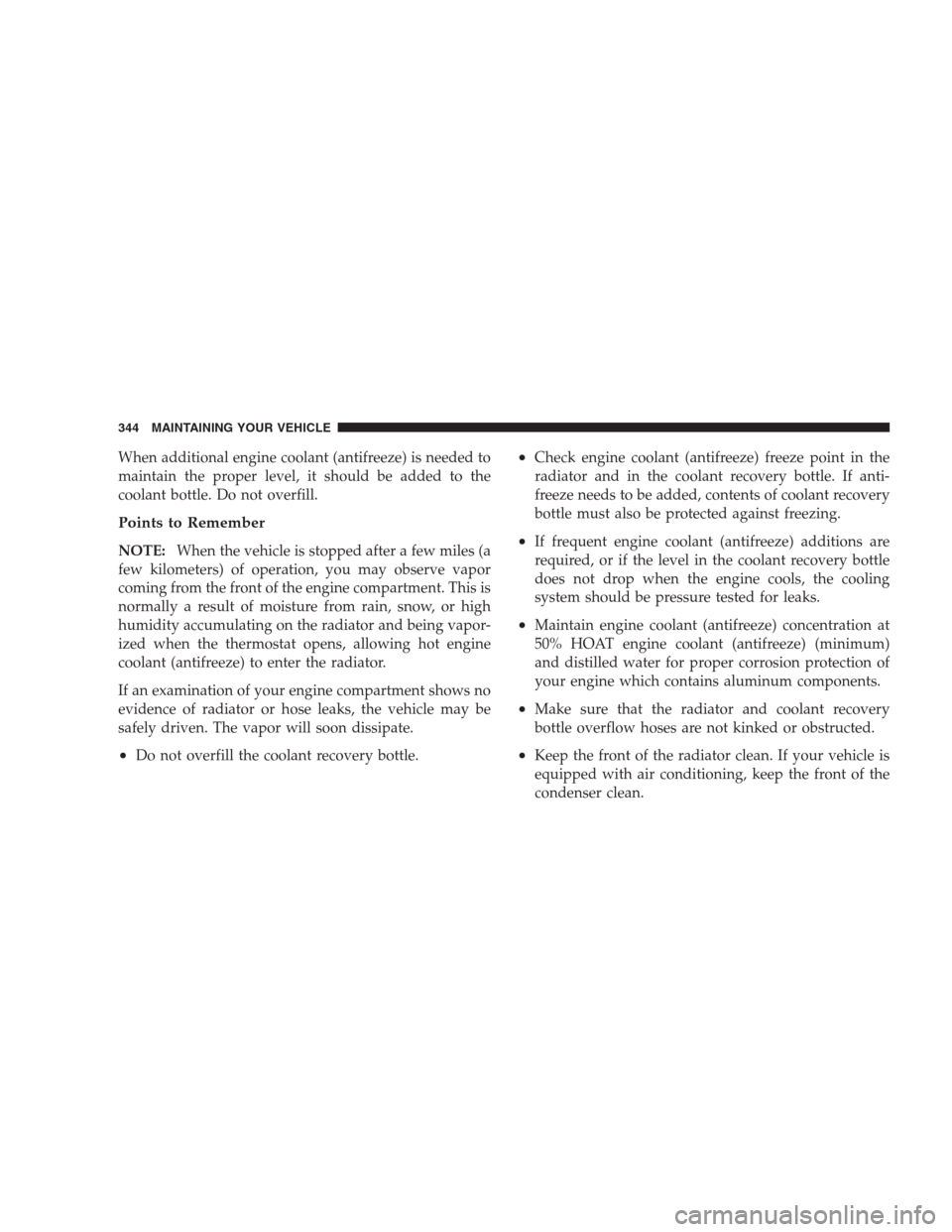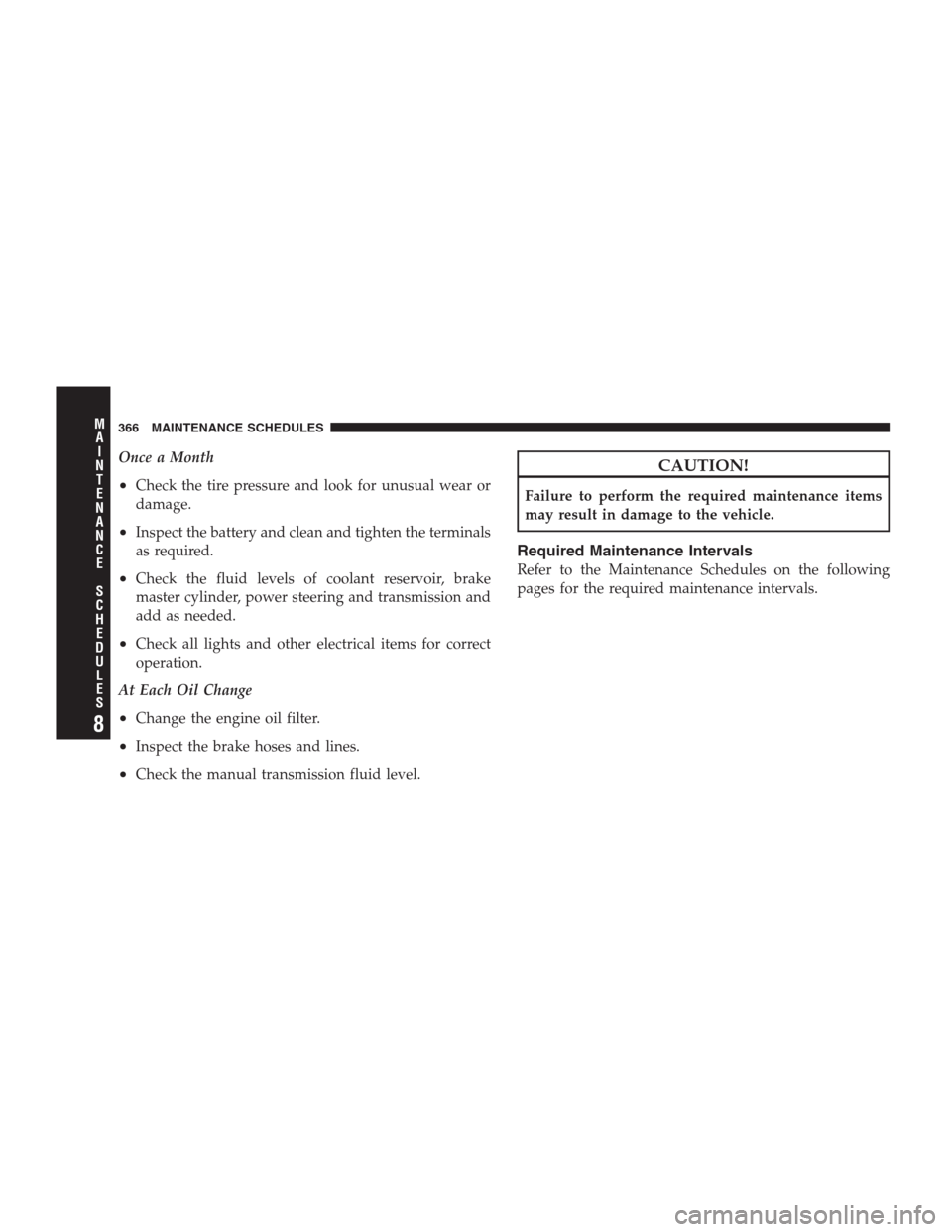2009 DODGE CALIBER SRT check engine
[x] Cancel search: check enginePage 342 of 411

WARNING! (Continued)
•You or others can be badly burned by hot engine
coolant (antifreeze) or steam from your radiator. If
you see or hear steam coming from under the
hood, do not open the hood until the radiator has
had time to cool. Never try to open a cooling
system pressure cap when the radiator is hot.
Coolant Checks
Check engine coolant (antifreeze) protection every
12 months (before the onset of freezing weather, where
applicable). If the engine coolant (antifreeze) is dirty or
rusty in appearance, the system should be drained,
flushed and refilled with fresh engine coolant (anti-
freeze). Check the front of the A/C condenser for any
accumulation of bugs, leaves, etc. If dirty, clean by gently
spraying water from a garden hose vertically down the
face of the condenser.Check the coolant recovery bottle tubing for brittle rub-
ber, cracking, tears, cuts and tightness of the connection
at the bottle and radiator. Inspect the entire system for
leaks.
Cooling System — Drain, Flush and Refill
If the engine coolant (antifreeze) is dirty or contains a
considerable amount of sediment, clean and flush with a
reliable cooling system cleaner. Follow with a thorough
rinsing to remove all deposits and chemicals. Properly
dispose of the old engine coolant (antifreeze) solution.
Refer to the “Maintenance Schedule” in Section 8 for the
proper maintenance intervals.
Selection Of Coolant
Use only the manufacturer’s recommended engine cool-
ant (antifreeze). Refer to “Fluids, Lubricants, and Genu-
ine Parts” in this section for the correct fluid type.
340 MAINTAINING YOUR VEHICLE
Page 345 of 411

WARNING!
•The warning words “DO NOT OPEN HOT” on
the cooling system pressure cap are a safety pre-
caution. Never add engine coolant (antifreeze)
when the engine is overheated. Do not loosen or
remove the cap to cool an overheated engine. Heat
causes pressure to build up in the cooling system.
To prevent scalding or injury, do not remove the
pressure cap while the system is hot or under
pressure.
•Do not use a pressure cap other than the one
specified for your vehicle. Personal injury or en-
gine damage may result.
Disposal of Used Engine Coolant
Used ethylene glycol based engine coolant (antifreeze) is
a regulated substance requiring proper disposal. Check
with your local authorities to determine the disposalrules for your community. To prevent ingestion by ani-
mals or children, do not store ethylene glycol based
engine coolant (antifreeze) in open containers or allow it
to remain in puddles on the ground. If ingested by a
child, contact a physician immediately. Clean up any
ground spills immediately.
Coolant Level
The coolant bottle provides a quick visual method for
determining that the engine coolant (antifreeze) level is
adequate. With the engine idling and warm to normal
operating temperature, the level of the engine coolant
(antifreeze) in the bottle should be between the “ADD”
and “FULL” lines, shown on the bottle.
The radiator normally remains completely full, so there is
no need to remove the radiator cap unless checking for
engine coolant (antifreeze) freeze point or replacing cool-
ant. Advise your service attendant of this. As long as the
engine operating temperature is satisfactory, the coolant
bottle need only be checked once a month.
MAINTAINING YOUR VEHICLE 343
7
Page 346 of 411

When additional engine coolant (antifreeze) is needed to
maintain the proper level, it should be added to the
coolant bottle. Do not overfill.
Points to Remember
NOTE:When the vehicle is stopped after a few miles (a
few kilometers) of operation, you may observe vapor
coming from the front of the engine compartment. This is
normally a result of moisture from rain, snow, or high
humidity accumulating on the radiator and being vapor-
ized when the thermostat opens, allowing hot engine
coolant (antifreeze) to enter the radiator.
If an examination of your engine compartment shows no
evidence of radiator or hose leaks, the vehicle may be
safely driven. The vapor will soon dissipate.
•Do not overfill the coolant recovery bottle.
•Check engine coolant (antifreeze) freeze point in the
radiator and in the coolant recovery bottle. If anti-
freeze needs to be added, contents of coolant recovery
bottle must also be protected against freezing.
•If frequent engine coolant (antifreeze) additions are
required, or if the level in the coolant recovery bottle
does not drop when the engine cools, the cooling
system should be pressure tested for leaks.
•Maintain engine coolant (antifreeze) concentration at
50% HOAT engine coolant (antifreeze) (minimum)
and distilled water for proper corrosion protection of
your engine which contains aluminum components.
•Make sure that the radiator and coolant recovery
bottle overflow hoses are not kinked or obstructed.
•Keep the front of the radiator clean. If your vehicle is
equipped with air conditioning, keep the front of the
condenser clean.
344 MAINTAINING YOUR VEHICLE
Page 348 of 411

WARNING!
Use of a brake fluid that may have a lower initial
boiling point or unidentified as to specification, may
result in sudden brake failure during hard prolonged
braking. You could have an accident.
CAUTION!
Use of improper brake fluids will affect overall
clutch system performance. Improper brake fluids
may damage the clutch system resulting in loss of
clutch function and the ability to shift the transaxle.
WARNING!
Overfilling the brake fluid reservoir can result in
spilling brake fluid on hot engine parts and the
brake fluid catching fire.Use only brake fluid that has been in a tightly closed
container to avoid contamination from foreign matter.
Do not allow petroleum based fluid to contaminate the
brake fluid as seal damage will result!
Manual Transaxle
Lubricant Selection
Use only the manufacturer’s recommended transmission
fluid. Refer to “Fluids, Lubricants, and Genuine Parts” in
this section for the correct fluid type.
Fluid Level Check
Check the fluid level by removing the fill plug. The fluid
level should be between the bottom of the fill hole and a
point not more that 3/16 in (4.7 mm) below the bottom of
the hole.
Add fluid, if necessary, to maintain the proper level.
346 MAINTAINING YOUR VEHICLE
Page 367 of 411

NOTE:
•The oil change indicator message will not monitor the
time since the last oil change. Change your vehicles oil
if it has been six months since your last oil change and
even if the oil change indicator message is NOT
illuminated.
•Change your engine oil more often if you drive your
vehicle off-road for an extended period of time.
•Under no circumstances should oil change intervals
exceed 6,000 miles (10 000 km) or six months, which-
ever comes first.
Your authorized dealer will reset the oil change indicator
message after completing the scheduled oil change. If this
scheduled oil change is performed by someone otherthan your authorized dealer, the message can be reset by
referring to the steps described under “Oil Change
Required” in “Use Factory Settings” of the EVIC section
in this manual or under “Odometer/Trip Odometer” in
the Instrument Cluster Descriptions section of this
manual.
At Each Stop for Fuel
•Check the engine oil level about five minutes after a
fully warmed engine is shut off. Checking the oil level
while the vehicle is on level ground will improve the
accuracy of the oil level reading. Add oil only when
the level is at or below the ADD or MIN mark.
•Check the windshield washer solvent and add if
required.
MAINTENANCE SCHEDULES 365
8
M
A
I
N
T
E
N
A
N
C
E
S
C
H
E
D
U
L
E
S
Page 368 of 411

Once a Month
•Check the tire pressure and look for unusual wear or
damage.
•Inspect the battery and clean and tighten the terminals
as required.
•Check the fluid levels of coolant reservoir, brake
master cylinder, power steering and transmission and
add as needed.
•Check all lights and other electrical items for correct
operation.
At Each Oil Change
•Change the engine oil filter.
•Inspect the brake hoses and lines.
•Check the manual transmission fluid level.
CAUTION!
Failure to perform the required maintenance items
may result in damage to the vehicle.
Required Maintenance Intervals
Refer to the Maintenance Schedules on the following
pages for the required maintenance intervals.
366 MAINTENANCE SCHEDULES
8
M
A
I
N
T
E
N
A
N
C
E
S
C
H
E
D
U
L
E
S
Page 395 of 411

Brake Control System, Electronic............. 264
Brake Fluid............................ 361
Brake, Parking.......................... 259
Brake System........................260,345
Anti-Lock (ABS)....................... 261
Fluid Check.......................... 345
Master Cylinder....................... 345
Parking............................. 259
Warning Light........................ 169
Brakes.............................260,345
Break-In Recommendations, New Vehicle........ 69
Bulb Replacement.....................355,356
Bulbs, Light............................ 355
Capacities, Antifreeze (Engine Coolant)........ 359
Capacities, Fluid........................ 359
Caps, Filler
Fuel................................ 301
Oil (Engine).......................325,331Power Steering........................ 258
Car Washes............................ 348
Carbon Monoxide Warning................. 300
Cargo Area Cover....................... 149
Cargo Area Features...................... 147
Cargo Compartment
Light............................... 147
Cargo Light............................ 147
Cargo Load Floor........................ 149
Cargo Tie-Downs........................ 150
Caution, Exhaust Gas...................... 70
Cellular Phone........................81,238
Center High Mounted Stop Light............ 358
Chains, Tire............................ 285
Chart, Tire Sizing........................ 272
Check Engine Light
(Malfunction Indicator Light)............... 327
Child Restraint.......................... 61
Child Restraint Tether Anchors............... 65
INDEX 393
10
Page 397 of 411

Dipsticks
Power Steering........................ 258
Disposal
Antifreeze (Engine Coolant)............... 343
Engine Oil........................... 332
Door Locks............................. 27
Door Locks, Automatic.................... 28
Door Opener, Garage..................... 134
Downshifting.......................... 253
Driver’s Seat Back Tilt.................... 116
Driving
On Slippery Surfaces.................... 254
Through Flowing, Rising, or Shallow
Standing Water......................... 255
Electric Remote Mirrors.................... 79
Electrical Power Outlets................... 144
Electronic Brake Control System............. 264
Brake Assist System.................... 264Electronic Stability Program............... 265
Traction Control System................. 264
Electronic Speed Control (Cruise Control)...... 131
Electronic Stability Program (ESP)............ 265
Electronic Vehicle Information Center (EVIC).... 174
Emergency, In Case of
Jump Starting......................... 317
Towing............................. 320
Emission Control System Maintenance......327,364
Engine............................... 325
Break-In Recommendations................ 69
Checking Oil Level..................... 329
Cooling............................. 339
Exhaust Gas Caution.................... 300
Fuel Requirements..................... 296
Jump Starting......................... 317
Oil ...........................329,359,360
Oil Change Interval.................... 330
Oil Filler Cap......................325,331
INDEX 395
10